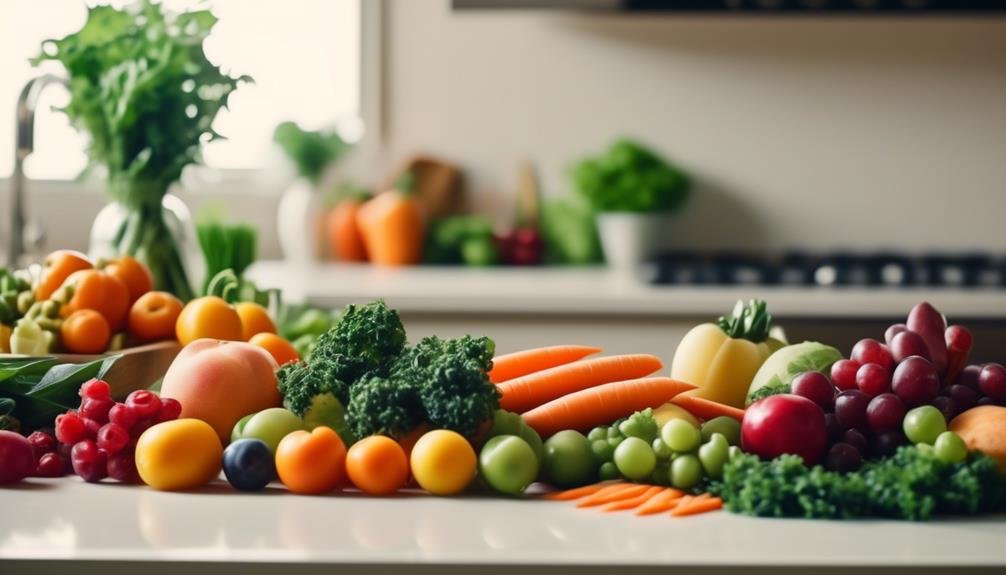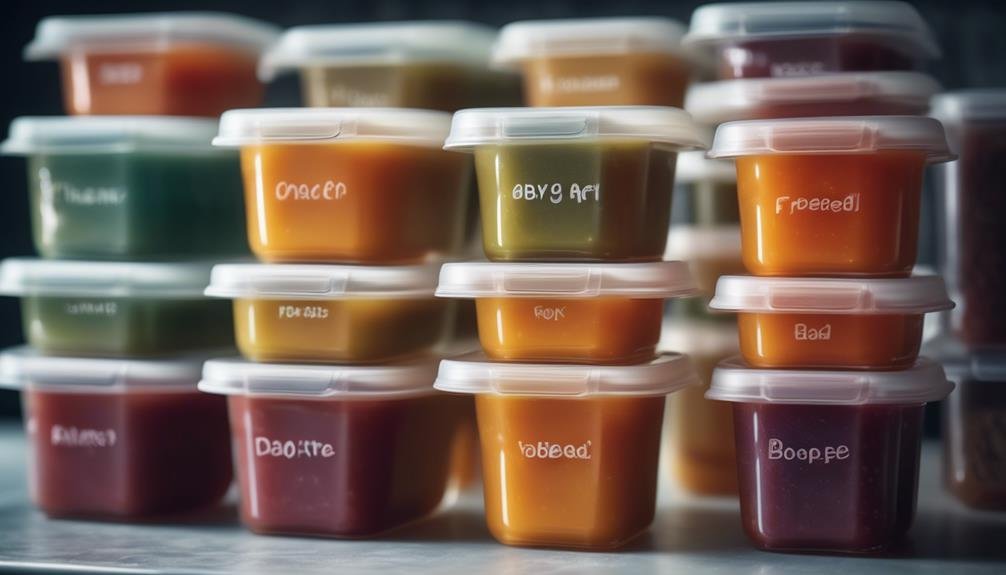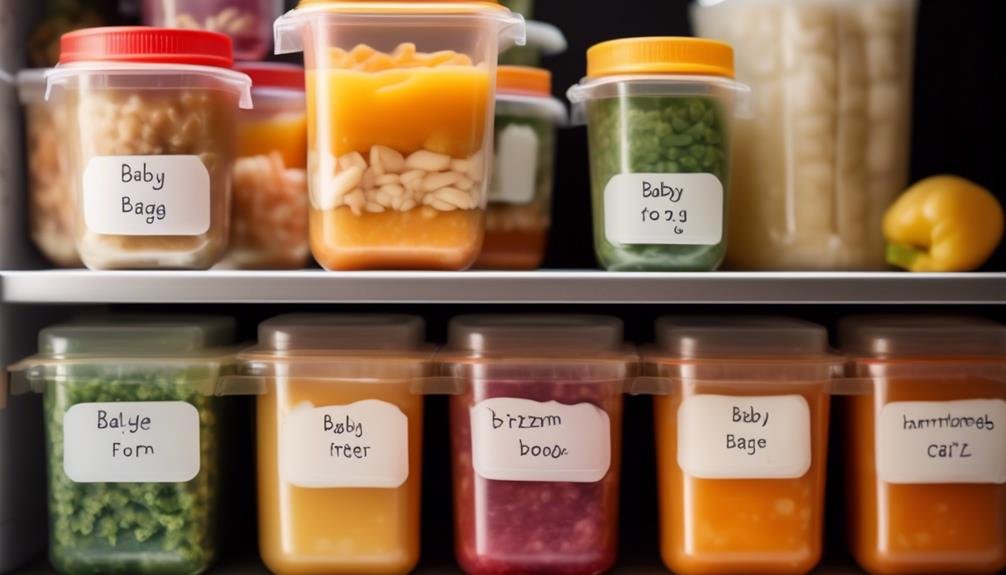"Cherishing Little Steps - A Haven for Baby and Family Journeys"
Freezing Homemade Baby Food
Are you ready to take your baby's meals to the next level?
Freezing homemade baby food is like hitting two birds with one stone – you not only ensure that your little one gets the best nutrition, but you also save time and effort in the long run.
But how exactly does freezing baby food work? And what are the best techniques to ensure that the taste and nutrients are preserved?
In this discussion, we will explore the ins and outs of freezing homemade baby food, from choosing the right ingredients to proper storage and thawing techniques.
Get ready to elevate your baby's mealtime experience!
Key Takeaways
- Freezing homemade baby food preserves nutrients and extends shelf life.
- It provides convenience and slows down the growth of bacteria, yeast, and mold.
- Choosing the right ingredients, such as organic produce, is important.
- Proper storage techniques, including labeling and dividing into smaller portions, are necessary for easy thawing.
Benefits of Homemade Baby Food

When you make your own baby food at home, you can reap a multitude of benefits that contribute to your child's health and well-being. One of the main advantages of preparing baby food at home is that it's a cost-effective option. Buying pre-packaged baby food can be expensive, especially when you consider the amount of food your little one will consume as they grow. By making your own baby food, you can save money in the long run and have more control over your budget.
Another significant benefit of homemade baby food is the ability to have nutritional control. When you prepare your baby's meals, you have full control over the ingredients you use. You can ensure that your baby receives a variety of nutrients and avoid additives or preservatives that may be present in store-bought options. This allows you to prioritize your child's health and tailor their meals to their specific needs.
In addition to being cost-effective and offering nutritional control, making your own baby food also allows you to introduce your child to a wide range of flavors and textures. By exposing them to different tastes early on, you can help develop their palate and encourage healthy eating habits in the future.
Why Freeze Baby Food?
To ensure the longevity and convenience of your homemade baby food, freezing is a practical and efficient option. Freezing your baby food not only helps to preserve its nutrients but also provides a great convenience factor for busy parents.
By freezing homemade baby food, you can extend its shelf life and ensure that your little one is getting the same amount of nutrients as when it was freshly made. Freezing slows down the growth of bacteria, yeast, and mold, which can cause spoilage and foodborne illnesses. It also helps to retain the essential vitamins and minerals that are vital for your baby's growth and development.
In addition to preserving nutrients, freezing baby food offers a significant convenience factor. By preparing and freezing large batches of baby food, you can save time and effort in the long run. Simply thaw and heat the frozen portions whenever your baby needs a meal, eliminating the need for frequent food preparation. This is especially beneficial for working parents or those with a busy schedule.
To better understand the benefits of freezing homemade baby food, take a look at the table below:
| Benefits of Freezing Homemade Baby Food |
|---|
| Preserves nutrients |
| Extends shelf life |
| Provides convenience factor |
Choosing the Right Ingredients

Choosing the right ingredients for homemade baby food is crucial for providing your little one with nutritious and wholesome meals. When it comes to selecting ingredients, opting for organic produce can be a great choice. Organic fruits and vegetables are grown without the use of synthetic pesticides, fertilizers, or genetically modified organisms (GMOs). This means that the food your baby consumes will be free from potentially harmful chemicals, promoting their overall health and well-being.
Additionally, it's important to consider introducing allergenic foods gradually and in a controlled manner. Common allergenic foods include peanuts, eggs, dairy, and wheat. It's recommended to introduce one new allergenic food at a time, waiting a few days before introducing another. This allows you to monitor your baby for any signs of allergies or sensitivities.
If your baby has a family history of allergies, it may be beneficial to consult with a pediatrician before introducing allergenic foods.
Preparing and Cooking Baby Food
To prepare and cook homemade baby food, start by washing and peeling the fruits and vegetables you have chosen. This helps remove any dirt or residue that may be present.
Once cleaned, you can begin the process of batch cooking, which involves cooking a large quantity of food at once and storing it for later use. This saves time and ensures that you always have a supply of fresh baby food on hand.
After cooking, allow the food to cool before pureeing it into a smooth consistency. Pureeing fruits and vegetables helps break them down into a texture that's safe and easy for your baby to consume. When pureeing, you can add a little water or breast milk to achieve the desired consistency.
It's important to note that while pureeing, you should remove any seeds, pits, or skins that may pose a choking hazard.
Proper Storage Techniques

Consider these proper storage techniques to ensure the freshness and safety of your homemade baby food.
Proper storage is essential in maintaining the quality and nutritional value of the food while preventing spoilage. To maximize the shelf life of your baby food, it's important to store it in airtight containers. Mason jars or BPA-free plastic containers with tight-fitting lids are great options.
Make sure to label each container with the date of preparation to keep track of its freshness. When freezing baby food, divide it into smaller portions to prevent unnecessary thawing. This way, you can easily take out the required amount without exposing the rest to potential contamination.
For optimal safety, it's recommended to freeze baby food within 24 hours of preparation. Additionally, try to use frozen baby food within 1-3 months to maintain its quality. To prevent the growth of harmful bacteria, always thaw baby food in the refrigerator or using a microwave on a low setting.
Remember to discard any leftovers that have been left at room temperature for more than 2 hours. By following these proper storage techniques, you can ensure that your homemade baby food remains fresh, safe, and packed with nutrients for your little one.
Freezing in Ice Cube Trays
To freeze homemade baby food in ice cube trays, simply transfer the puree into each compartment and place the tray in the freezer. Freezing baby food in ice cube trays is a convenient and practical method that allows you to portion and store the food in individual servings.
Here are some benefits of using ice cube trays for freezing baby food:
- Portion control: Each compartment in the ice cube tray holds a small amount of baby food, making it easy to control the portion size for each meal.
- Convenience: Once the baby food puree is frozen in the ice cube trays, you can easily pop out the desired number of cubes whenever you need them, saving you time and effort.
- Versatility: The small size of the ice cube trays allows you to mix and match different flavors and combinations of baby food, providing variety and introducing new tastes to your little one.
- Space-saving: Ice cube trays take up minimal space in the freezer, allowing you to maximize storage capacity for other food items.
While freezing baby food in jars is another alternative method, ice cube trays offer more flexibility and convenience. They're also easier to clean and take up less space.
Whether you choose ice cube trays or jars, both methods ensure that your homemade baby food stays fresh and ready to serve whenever your little one is hungry.
Using Freezer Bags or Containers

If you prefer an alternative to freezing baby food in ice cube trays, you can use freezer bags or containers to store and preserve your homemade purees.
Freezer bags are a convenient option for freezing baby food because they're easy to use and take up less space in the freezer compared to ice cube trays. Simply pour the puree into the bag, squeeze out any excess air, seal it tightly, and lay it flat in the freezer. This method allows you to easily portion out the desired amount of food when needed.
Freezer containers are another great option for storing purees. Look for containers made specifically for freezing baby food, as they're usually BPA-free and designed to prevent freezer burn. Make sure to leave some room at the top of the container to allow for expansion as the puree freezes.
Both freezer bags and containers are suitable for storing purees for up to three months. Remember to label each bag or container with the date and type of food for easy identification.
With these freezing methods, you can conveniently store and preserve your homemade baby food.
Thawing and Reheating Baby Food
Thaw and reheat your homemade baby food with these simple steps. When it comes to reheating methods, there are a few best thawing practices that you can follow to ensure the safety and quality of your baby's meal.
Here are some tips to help you thaw and reheat your baby food effectively:
- Thawing in the refrigerator: Place the frozen baby food in the refrigerator overnight to thaw slowly. This method helps retain the nutrients and minimizes the risk of bacterial growth.
- Thawing in warm water: If you need to thaw the baby food quickly, you can place the frozen container in a bowl of warm water. Make sure to use warm water and not hot water to prevent overheating the food.
- Reheating on the stovetop: Gently heat the thawed baby food in a saucepan over low to medium heat. Stir frequently to ensure even heating and prevent hot spots.
- Microwaving with caution: If you choose to use a microwave, be cautious as it can heat unevenly and create hot spots. Stir the baby food thoroughly and test the temperature before feeding it to your little one.
Recommended Baby Food Recipes

When it comes to providing nutritious meals for your little one, exploring recommended baby food recipes is an exciting way to introduce a variety of flavors and textures. As you begin introducing solids to your baby, having the right baby food equipment is essential. A good blender or food processor will help you create smooth purees, while a steamer and a steaming basket will allow you to cook vegetables and fruits to perfection.
Here are some recommended baby food recipes to get you started:
| Stage 1 (4-6 months) | Stage 2 (6-8 months) | Stage 3 (8-10 months) | Stage 4 (10-12 months) |
|---|---|---|---|
| Single-ingredient purees (e.g., sweet potatoes, avocados) | Combination purees (e.g., apple and banana) | Thicker purees with soft chunks (e.g., chicken and rice) | Soft finger foods (e.g., cooked pasta, small pieces of fruits) |
Remember to introduce one new ingredient at a time and wait a few days before introducing another to check for any potential allergies. As your baby grows, you can start experimenting with different flavors and textures, gradually moving towards a variety of mashed and chopped foods.
Frequently Asked Questions
How Can I Ensure That Homemade Baby Food Retains Its Nutrients After Freezing?
To ensure your homemade baby food retains its nutrients after freezing, follow these tips: 1) Use fresh ingredients, 2) Cook them lightly, 3) Puree the food, 4) Allow it to cool before freezing.
Is It Safe to Freeze Baby Food That Contains Meat or Fish?
"Hey, freezing baby food with meat or fish? Totally safe! Just make sure you cook it thoroughly, puree it well, and store it in airtight containers. Your little one will love it!"
Can I Freeze Homemade Baby Food in Glass Jars?
Yes, you can freeze homemade baby food in glass jars. It's important to use jars specifically designed for freezing. Alternatively, you can store homemade baby food in plastic containers or refrigerate it instead of freezing.
How Long Can I Keep Frozen Baby Food in the Freezer?
You can keep frozen baby food in the freezer for up to three months. It's a great way to have convenient meals for picky eaters. When thawing, use the fridge or microwave and stir well before serving.
Can I Freeze Baby Food That Contains Dairy Products?
Yes, you can freeze baby food that contains dairy products. However, if you prefer alternatives to dairy in frozen baby food, you can use breast milk, formula, or non-dairy milk substitutes.
Conclusion
In conclusion, freezing homemade baby food is a convenient and practical way to provide nutritious meals for your little one. By using proper storage techniques and choosing the right ingredients, you can ensure that your baby's food remains fresh and retains its nutritional value.
Whether you freeze in ice cube trays or freezer bags, thawing and reheating is easy. With these tips and recommended recipes, you can confidently give your baby the best start to their culinary journey.


